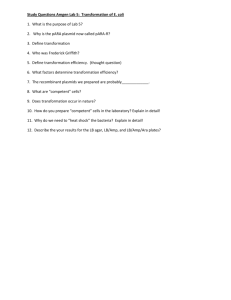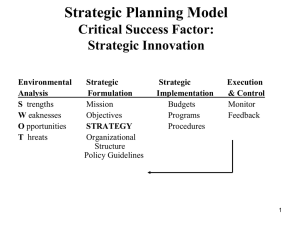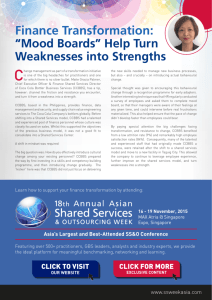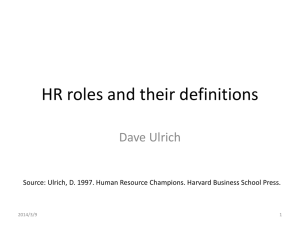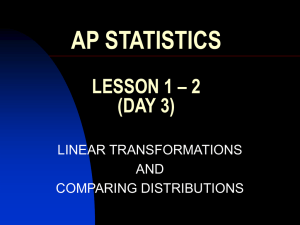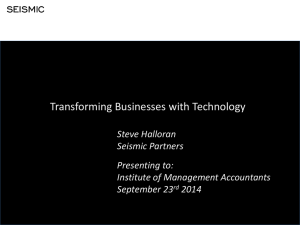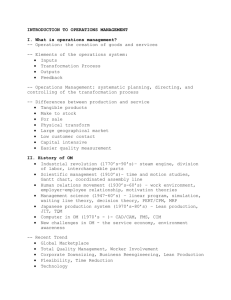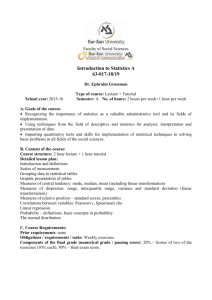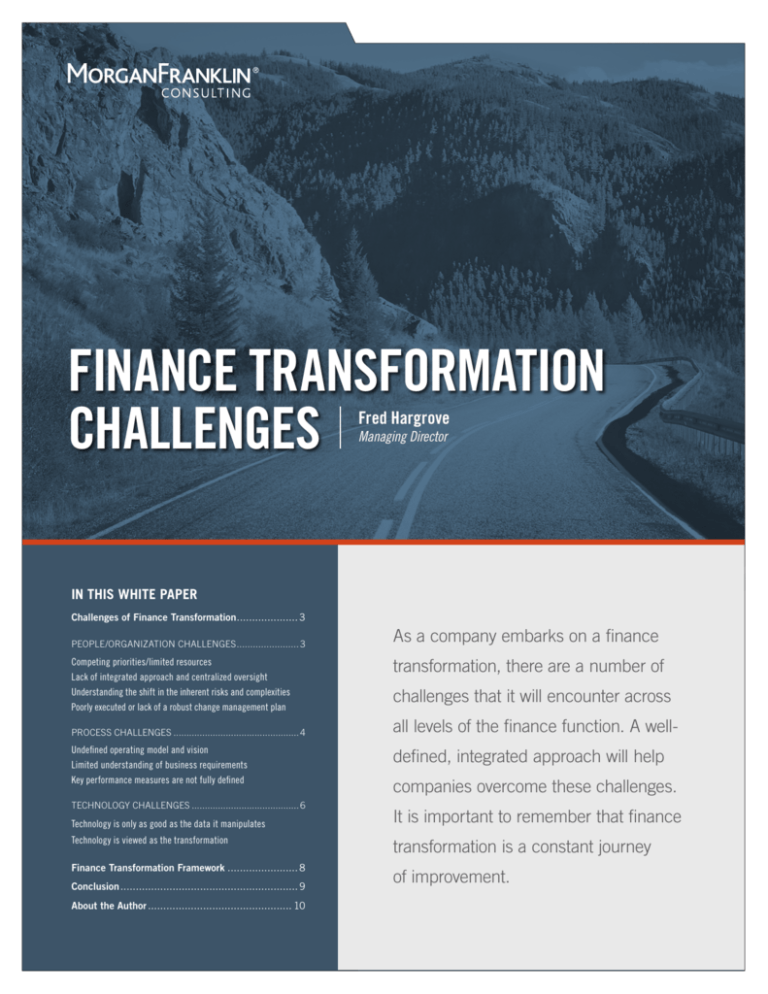
FINANCE TRANSFORMATION
CHALLENGES
Fred Hargrove
Managing Director
IN THIS WHITE PAPER
Challenges of Finance Transformation..................... 3
PEOPLE/ORGANIZATION CHALLENGES........................ 3
Competing priorities/limited resources
Lack of integrated approach and centralized oversight
Understanding the shift in the inherent risks and complexities
Poorly executed or lack of a robust change management plan
PROCESS CHALLENGES................................................. 4
Undefined operating model and vision
Limited understanding of business requirements
Key performance measures are not fully defined
TECHNOLOGY CHALLENGES.......................................... 6
Technology is only as good as the data it manipulates
As a company embarks on a finance
transformation, there are a number of
challenges that it will encounter across
all levels of the finance function. A welldefined, integrated approach will help
companies overcome these challenges.
It is important to remember that finance
Technology is viewed as the transformation
transformation is a constant journey
Finance Transformation Framework........................ 8
of improvement.
Conclusion........................................................... 9
About the Author................................................ 10
FIN A N CE T R A NSFO RM ATIO N CH A L L EN GES
Introduction
Business literature on finance
transformation is abundant, and most
of what is available focuses on the
drivers of finance transformation,
the “Why,” or the results of finance
transformation, the “Wow.” However,
there is very little available that
addresses the challenges of executing
finance transformation, the “How.”
Our objective is to provide organizations
with insight that can be translated into
action. For those organizations planning
a major finance transformation, our
experience shared here will help to avoid
the various pitfalls that are typically
encountered during transformation
efforts. For organizations that have
already begun the journey of finance
transformation, we hope our insights will
provide a reference point to help keep
the organizations’ efforts on track or to
improve the results of troubled programs.
The context of our insight is based on
the knowledge and experience of the
author, who has been providing consulting
services to the finance function for
more than 20 years. In addition,
the insights in this white paper were
validated by MorganFranklin’s executive
team, which includes seasoned finance
transformation experts who have a
breadth of experience across multiple
industries and organizations in all aspects
of finance transformation—including
process redesign, program management,
system integration, data management,
and change management.
Companies undertake finance
transformation for numerous reasons,
including:
•
Cost takeout
•
Improved performance
•
Enhanced controls
•
Integration of M&A activity
While the word “transformation” is
generally applied to all operational
improvement initiatives, we tend to
view finance transformation as the
implementation of organization, process,
and technology changes with the goal
of dramatically increasing the efficiency
and effectiveness of the finance function.
By improving the efficiency of financial
processes, organizations can see both
a reduction in the cost to perform
transaction processing and financial
reporting, and an improvement in data
quality. In turn, efficient transaction
processing allows finance organizations
to refocus resources on value-added
activities like decision making and
improving the control environment.
By improving both efficiency and
effectiveness, finance transformation
results in a finance organization that
is more aligned with and valuable to
the business.
As a company embarks on a finance
transformation, there are a number of
challenges that it will encounter across
all levels of the finance function. A welldefined, integrated approach will help
companies overcome these challenges.
It is important to remember that finance
transformation is a constant journey of
improvement.
© MorganFranklin Consulting, LLC. All rights reserved.
2
Challenges of Finance Transformation
Companies undergoing finance transformation experience
challenges across people/organization, processes, and systems.
It is often a combination of challenges across these three
pillars and in the “gray areas” between them that poses the
most risk. The following are a few of the common challenges
that we have witnessed on transformation projects.
When companies try to use internal staff
to resource both the transformation efforts
and day-to-day operations, the duration
of transformation efforts of this nature
typically results in “transformation fatigue.”
PEOPLE/ORGANIZATION CHALLENGES
Competing priorities/limited resources
Challenge: Companies often try to conduct a transformation with
only internal resources. This puts incredible pressure on dayto-day delivery of finance operations. When companies try
to use internal staff to resource both the transformation efforts
and day-to-day operations, the duration of transformation efforts of
this nature typically results in “transformation fatigue.” This is
because the companies are asking the finance staff to effectively
deliver over 100 percent productivity—working their “day jobs”
while also moving forward on the transformation path. While
this can be accomplished for a short period, it is typically not
sustainable and often results in a negative impact to the quality
of the output for finance operations and delayed (or suboptimized) results for the transformation effort. It may also
result in untimely turnover of key resources needed for the
end-state organization.
Recommendation: Management must realize it is likely that the
overall cost of finance will increase during the implementation
of finance transformation efforts. As transformation activities
are delivered over the course of the project, the company will
begin to realize benefits, but there will likely be a period of time
when the cost for finance increases rather than decreases. This
is because as transformation changes are adopted, companies
encounter a certain degree of FTE requirements for day-to-day
operations that result from the finance organization dedicating
its best and brightest to the transformation efforts. Setting
realistic milestones and allowing the management team to
stabilize operations with backfill resources will help to keep the
momentum and motivation up to continue transformation efforts.
Other approaches include structuring incentive or retention
awards tied to achievement of transformation milestones for
critical resources.
Lack of integrated approach and centralized oversight
Challenge: Companies that attempt to execute finance
transformation through a series of non-integrated, individually
managed projects will experience significant delays and cost
overruns. In our view, this results from a combination of a
silo or departmental approach to the finance function and a
general lack of deep program management expertise. Due to
the eventuality of competing priorities and political barriers,
companies cannot transform by making incremental changes
within silos. In addition, the degree of program management
skills required to adequately manage and provide oversight over
transformation initiatives could be greater than most companies
anticipate.
Recommendation: Since most transformation efforts span longer
periods of time, we recommend that clients empower a strong
program management team to support the efforts. Depending
upon the forecasted timeline for transformation, organizations
may want to hire resources with deep program management
expertise and/or consider augmenting internal resources with
temporary outside support. For many reasons, companies often
INTEGRATED LIFE CYCLE PROGRAM MODEL
Finance
Transformation
Program Steering
Committee
Program
Management Office
Procure
to Pay
Order to
Cash
Hire to
Retire
Record to
Report
www.morganfranklin.com
3
FIN A N CE T R A NSFO RM ATIO N CH A L L EN GES
look for consultants to fill this role. First and foremost, because
of their diverse range of experience, external resources provide
objectivity and offer a voice to the organization that is not
entrenched in previous ways of doing business. This external
voice is not as influenced by company politics and may be better
suited to recommend the tough or unpopular viewpoints that true
transformation may require. As transformation resources are often
not sustained in the long term, companies may also choose to
use external resources to control headcount and ongoing salary
spend.
Whether the program management function is sourced
internally or externally, organizations should have the central
oversight structure in place to establish an integrated plan,
clear measures of success, and the mechanisms to monitor and
execute initiatives in an integrated fashion. It is imperative for
the program management team to have a broad organizational
perspective in order to establish and manage an integrated
plan. The program management team should monitor the
interdependencies among the progress of different groups
within finance and highlight risks associated with deviations
from the established plan. If the program management function
is not elevated to the highest levels of the finance organization,
it will not be successful in driving efficiencies across the
traditional silos that exist in most finance organizations.
Understanding the shift in the inherent risks and
complexities
Challenge: During the transformation process, the finance
organization will go through a series of changes. Often these
changes will improve efficiency, but they may also introduce
a different level of complexity and risk. As an organization
transforms, the typical pattern is to become less decentralized and
then subsequently increase the degree of outsourcing, resulting
in a hybrid organization made up of internal and external
resources performing finance tasks. The increase in complexity
in managing hybrid organizations is not always anticipated.
Recommendation: As an organization moves through the stages
of transformation, finance executives need to recognize the
importance of organizational design and restructuring activities
that are required to anticipate the sizing and needed capabilities.
These activities tend to be required over the life of the
transformation—not just at a single point in time. If managed
appropriately, the organization will be more likely to efficiently
manage the changes to operational complexity and the risks
related to ongoing organizational structure changes.
Poorly executed or lack of a robust change management
plan
Challenge: We have observed companies struggling to
keep management and staff engaged in supporting finance
transformation efforts due to disjointed and limited change
management activities. Often companies are undergoing a
system change in conjunction with the transformation efforts.
When this is the case, it is common for a company to seek to
cut overall program costs due to budget constraints. This is a
very risky approach because it typically results in the company
squeezing budget out of change management activities, which
has a direct impact on the staff’s level of engagement. By
definition, a transformation effort is designed to dramatically
change the way the organization performs. As such, it would
seem obvious that change management is the last place
organizations should look to close budgetary gaps.
Recommendation: We recommend that management insist on
a robust change management program throughout the life
of the transformation effort. What is needed at the outset
of a transformation effort is a tailored change management
plan that takes into account the nuances of the organization’s
culture. The culture of an organization can either hinder or
help transformation. For example, we have observed that
decentralized cultures foster resistance to change because
it is difficult to build consensus. The level of effort around
change management will be variable over the course of
the transformation, but it is important to plan the change
management activities from the outset. At all key change
points in the effort, targeted change activities should be
designed and deployed.
PROCESS CHALLENGES
Undefined operating model and vision
Challenge: In our experience, companies sometimes embark
on finance transformation activities without having created a
well-defined end-state global operating model. This operating
model is the blueprint for how the organization will operate going
forward. Finance transformation without a target operating model
can cause delays in transformation efforts and cost overruns due
to rework. The overruns and rework can occur due to a lack of
clarity of the desired end state across the various workstreams
that make up the transformation effort. This lack of clarity can
cause key stakeholders to resist the transformation efforts
because they do not understand where they fit in the end-state
operating model.
Recommendation: To develop a clear vision for
transformation, we suggest assembling a small team to establish
the high-level strategy and business case. In order to develop a
coherent and transformational operating model, this team should
have cross-functional and organizational representation, and
should be viewed as independent from all legacy operations.
The team’s approach should be focused on looking at the core
© MorganFranklin Consulting, LLC. All rights reserved.
4
life cycles (e.g., procure to pay) to identify transformational
opportunities that may not be detected when only performing
functional-level analysis. The end-state global operating model
should include all planned components of the finance function’s
infrastructure, including the organizational alignment, functional
processes, and technology across each major service category
(transactional, specialty, and decision support). The key output of
visioning sessions is to define the target state.
Finance transformation without a target
operating model can cause delays in
transformation efforts and cost overruns due
to rework.
Once the high-level strategy and end-state operating model
are developed, validation sessions should be held across the
appropriate levels within the organization. These collaborative
validation sessions provide valuable insights that can be used
to enhance the high-level strategy and confirm or improve the
business case assumptions. They also function as a change
management tool to get the entire organization behind the
transformation effort. The transformation team should then take
the final strategy and develop a high-level roadmap that tells the
finance stakeholders what changes are required to achieve the end
state, and when the benefits from those changes will result. The
combination of this roadmap and the strategy and business case
can then be used to clearly communicate the vision for the finance
transformation.
Limited understanding of business requirements
Challenge: Typically the feedback received from process owners
going through finance transformation is that not enough time was
dedicated to understanding their business requirements prior to
embarking on driving dramatic changes to business processes and
the underlying technology infrastructure. This empowers users to
resist change by identifying deficiencies in the end-state vision
based upon unmet requirements. Another common complaint
is that requirements are difficult to define in a ”greenfield”
environment, so it may be useful to provide a broad outline
of the target environment to give stakeholders a context in which
to describe their business needs.
Recommendation: To develop detailed business requirements,
we suggest capturing requirements using an iterative process
that begins very early in the life cycle of the transformation.
Requirements should be constantly captured, enhanced, and
www.morganfranklin.com
5
FIN A N CE T R A NSFO RM ATIO N CH A L L EN GES
verified across the major components of the program.
1.Strategy Development—Conduct work sessions with
key business owners to gain an understanding of their
informational, workflow, system functionality, and control
requirements and priorities.
2.Validation Sessions—Refine and enhance requirements during
validation discussions with business owners.
3.Detailed Design—After completing the strategic design,
capture detailed requirements to drive the changes that must
take place to support the transformation efforts.
Without a constant focus on requirements, we have seen
companies develop unnecessary and inefficient workaround
solutions in order to meet the needs of the business.
We recommend establishing an approach for managing
requirements from the outset of the transformation efforts.
Key performance measures are not fully defined
Challenge: Finance transformation is often undertaken without
first fully defining key performance measures. Performance
measures should evolve and change over time, but if the key
measures that aid in evaluating performance are not identified,
it will be difficult to identify performance gaps and prioritize
the actions that need to be taken to close those gaps.
Additionally, this makes it difficult to establish baseline
performance to measure success against, and also to build the
business case required to capture support for the transformation
effort.
Recommendation: If key performance measures are not fully
defined, organizations will be unable to establish how well
they are performing from both a qualitative and quantitative
perspective. It is recommended that current operations be
assessed and performance measures be captured across each
functional area. These measures should be based on either
external benchmarks (e.g., published sources) or internal
benchmarks (e.g., metrics from internal business units).
The measures will provide a baseline for current performance
which can then be used to identify the gap between current
and target performance.
It is not enough to just have performance measures in place.
Understanding the 10 to 20 criteria (maximum) that are required
to measure success is imperative. However, there are risks
associated with having too many measures:
1.Amount of time needed to measure performance
2.Diluted focus causes organizations to miss key indicators
that truly highlight performance direction
TECHNOLOGY CHALLENGES
Technology is only as good as the data it manipulates
ce Targets
ab
Est
to
ic s w
etr Re
L ink M t i o n &
a
Co m p e n s
ar
ds
CRITICAL
KPIs
Eva
lu
& D ate
a
n
ic s g f o r
m an
li s
P
or
er f
ic s
Me t r y
it
in g
i s t ab il
Ex Avail
ta
h
KEY PERFORMANCE MEASURES
r ti
ep o e t r
R
M
sh
E s t a b l i l e v an t
Re
Challenge: Many organizations do not focus enough effort
on addressing data management issues. As an organization
moves through transformation, data management tends to be
an afterthought of the system implementation. As a result,
the end-state systems infrastructure often does not capture
data as required by finance operations. This results in manual
workarounds to provide required reporting and analytics, which
in turn create inefficiencies and raise the risk of inaccurate
reporting. The need for manual workarounds also significantly
impacts the opportunity for the finance department to reduce
resource levels.
Recommendation: Companies should focus on information, data
management, and governance requirements from the outset of
the program. To accomplish this, we recommend establishing
a data architecture role in the transformation program. Early in
the transformation process, organizations need to identify the
data-related pain points and the appropriate course of action
to resolve them. Typical data management challenges include:
•
Ensuring data quality and integrity
•
Understanding informational requirements
© MorganFranklin Consulting, LLC. All rights reserved.
6
•
Identifying the appropriate data sources
•
Accessing timely data
Without a fundamental change in the way organizations manage
data assets overall, technology solutions are ineffective. Three
key concepts are necessary to begin to address data-related pain
points:
•
Appropriate data strategies
•
Usable and sustainable technology solutions
•
Rigorous standards and accountability
The successful enabling of these concepts requires ownership,
discipline, policies, governance, and a data management
plan that is integrated with the transformation program. This
will enable finance to provide business owners with better
information in a more efficient manner.
Technology is viewed as the transformation
Challenge: Organizations sometimes begin finance
transformation with a narrow focus on technology. It is
important to recognize that technology is a supporter of
transformation—it is not the transformation in its entirety.
Implementing new technology alone without giving consideration
to the needed process or organizational structure changes will not
achieve the desired transformation objectives.
THE FOUNDATION OF GOVERNANCE & STRATEGY
Governance & Strategy
Data
Standards &
Architecture
Data
Management
Tools
Education & Outreach
Enterprise Data Management Framework
•Defines
•S ets
a corporate-wide data strategy
data standards and governance
•Manages
measurement and correction of data
quality issues to ensure consistency
•A ssists
with development of, transition to, and
adherence to target data architecture
•Develops
Implementing new technology alone
without giving consideration to the needed
process or organizational structure
changes will not achieve the desired
transformation objectives.
Data
Quality
Resolution
Approach
an enterprise data integration plan
•Identifies
and deploys appropriate technologies
and tools for data management
•Performs
education and outreach for enterprise
data stakeholders
Recommendation: Before contemplating technology solutions,
we recommend that a strategic viewpoint first be developed.
How will processes run? How will resources be organized? Should
the company seek to outsource a significant portion of the finance
organization’s responsibilities? Once these macro-level decisions
are made, a detailed operating model can be developed that
specifies the process and organizational changes that will occur.
This operating model will then become the basis around which
an IT platform is selected that is most effective at supporting the
organization’s requirements.
www.morganfranklin.com
7
FIN A N CE T R A NSFO RM ATIO N CH A L L EN GES
Finance Transformation Framework
Our experience has shown that the challenges of finance
transformation described earlier are not unique to only a few
organizations. In the last decade, the complexity of the overall
business environment has increased substantially, rendering
the previously achieved advances as competitive necessities. In
addition, the pace of change and the degree of complexity seems
to be increasing without limits (e.g., constant regulatory changes,
demand for shorter internal and external reporting deadlines,
increasing focus on acquisitions, and increasing globalization
and operating in the network business model). The complexity
of today’s business environment multiplies the strain of the
challenges finance executives face when navigating finance
transformation.
The root causes of many of the challenges detailed earlier
stem from poor planning, limited communication, and a lack
of understanding of current capabilities and requirements. To
address these challenges, a flexible and integrated approach
to finance transformation is required. Organizations that have
undergone successful finance transformations have done so
by using an integrated approach that is based upon a solid
transformation framework.
Most finance transformations are driven by a set of unique
circumstances which in turn require a tailored approach when
managing those circumstances. In order for organizations to have
a successful finance transformation, there are certain elements
that must be considered to frame the approach. MorganFranklin’s
Finance Transformation Framework displays key elements that
are required for finance transformation to reach the expected
cost savings and efficiency targets. These elements provide a
framework to guide and monitor global transformation activities
and promote benefits realization. The challenges detailed in
this white paper can be traced back to the lack of one or more
of the required elements. MorganFranklin collaborates with
clients to define a unique and tailored approach based upon
consideration of the Finance Transformation Framework’s set
of key elements.
MorganFranklin has expertise and capabilities across the entire
framework, and the following is a summary of activities we can
engage in to help organizations achieve finance transformation:
•
Conduct envisioning sessions—Assist leadership with
designing a target or future state for the finance function.
•
Develop a blueprint—Create a comprehensive roadmap that
depicts how the future state will be achieved.
•
Conduct risk assessment—Develop a risk-based approach to
identify areas where more process standardization is needed.
© MorganFranklin Consulting, LLC. All rights reserved.
8
•
Change management—Design a targeted change management
campaign that will prepare the organization to adopt these
significant changes.
•
Performance management—Define measures of success
in order to measure and report against progress. Implement
required monitoring and reporting processes for tracking
achievement of objectives.
•
Organization design and transition—Define transition and
target state organizational structures. Outline key roles
and capabilities needed to support transition and target
organizations.
•
Establish finance PMO—Appoint a finance PMO who will
provide oversight and guidance on initiatives and help to
integrate all finance-related initiatives.
•
Evaluate BI environment—Architect the data management
and BI infrastructure, giving consideration to desired data
governance and reporting/analytical capabilities.
•
Develop and implement financial processes—Define and
implement core financial processes to support the defined
end-state objectives, giving consideration to the company’s
environment and industry best practices.
•
Design and implement integrated information systems—
Design and implement financial information systems that
are flexible and resilient to changing operational strategy.
Conclusion
The finance transformation journey can be quite rewarding
for those organizations that have a sound strategy and are
persistent. Successful transformations position finance to be a
valued, capable, and trusted “partner” to the operating units,
with deep knowledge of their business. To achieve this, the finance
organization must align to business strategy and then identify the
most cost-effective way to accomplish transaction processing
activities in order to focus on those that support mission
achievement (e.g., decision support, risk analysis, etc.).
Successful transformations position
finance to be a valued, capable, and trusted
“partner” to the operating units, with deep
knowledge of their business.
As discussed previously, obstacles to transformation exist
and tend to be similar across industries. An organization’s
finance transformation will include a number of concurrent
initiatives, and each of these initiatives will have a significant
MORGANFRANKLIN FINANCE TRANSFORMATION FRAMEWORK
Finance PMO
Business Unit
Business Unit
Business Unit
Business Unit
Business Unit
Business Unit
www.morganfranklin.com
9
FIN A N CE T R A NSFO RM ATIO N CH A L L EN GES
impact on the finance function. The elements of the Finance
Transformation Framework, if used properly, will guide and
structure an integrated approach. Experience has shown that
change of this magnitude will only achieve maximum benefits
if the underlying initiatives are executed in an integrated
fashion. By not adhering to a similar framework, organizations
undergoing finance transformation will be exposed to the
following types of risk:
•
Incurring additional costs due to duplication of efforts from
uncoordinated activities.
•
Delays and cost overruns due to limited view into dependencies
between initiatives.
•
Resistance against change due to lack of a comprehensive
change management plan that prepares the finance
organization for pending changes.
•
Not achieving desired cost reduction entirely or delaying the
achievement of potential savings.
•
Not correlating key finance capabilities with the needs of the
business due to an inability to prioritize and align initiatives.
About the Author
Fred Hargrove focuses on enterprise information management
(EIM), enterprise resource planning (ERP), and enterprise
performance management (EPM), applying more than 20 years
of Big Four accounting, industry, and consulting experience.
He specializes in optimizing processes, controls, technology,
and data to resolve the challenges that impede organizations’
financial and operational performance. Applying strong business
and operational process expertise, Fred’s work spans full life
cycle technology projects and business process initiatives
ranging from custom and packaged system implementations and
customer relationship management (CRM) to financial reporting,
budgeting, and planning.
Contact
Fred Hargrove
Managing Director
Information Management & Technology
financetransformation@morganfranklin.com
office: 703.564.7525
Our expertise and experience can help organizations
successfully execute their finance transformation goals and
objectives. We understand key elements that will drive these
finance transformation activities and can help develop a
properly integrated approach to mitigate the risks we have
described. We have a demonstrated track record with largescale transformation efforts and can be utilized to augment an
organization’s current knowledge base and capabilities to help
deliver a successful finance transformation program.
© MorganFranklin Consulting, LLC. All rights reserved.
10
About MorganFranklin Consulting
MorganFranklin is a strategy and execution-focused business
consulting firm and professional advisor. We provide strategic
thinking and hands-on support to help clients manage growth
and maximize performance. Our solutions always consider the
key connections between finance and accounting, operations,
technology, and risk—connections that are critical to success.
Clients say that our responsiveness, flexible style, and fast access
to proven professionals make us an invaluable business partner
and advisor.
www.morganfranklin.com
11
SFO-15-COMM-TL-3447

